Welcome to my post on the most valuable and rare Canadian quarters. Quarters are my favorite denomination to collect. I must admit though, that one of the difficulties that immediately presents itself here, has to do with organizing a list of valuable and rare Canadian quarters.
For instance, if I presented a simple top 10 list of rare Canadian quarters, then nearly every coin on the list would be Victorian quarters that pre-date 1900. Given that I’ve already written an article on rare Victorian Quarters, I thought I’d take a different approach here.
To showcase the diversity of Canada’s coin heritage, I’ve decided to present a list of rare Canadian Quarters by decade. Each quarter featured here is the rarest quarter found in that decade. So here is the list:
Rare Canadian Quarters
1875 H Quarter Queen Victoria
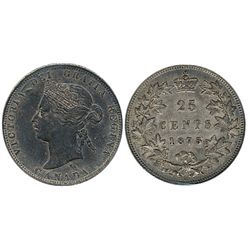
This coin is the “Queen of Canadian Quarters.” Charlton has listed the mintage for 1875H Quarters at 1 million coins minted. Given that it’s the rarest Victorian Quarter I have my doubts about that number.
After all, the 1889 Quarter discussed below was the lowest mintage Victorian Quarter, yet they don’t really compare to the 1875H in terms of rarity.
Anyway, this quarter sells for about $500-$1,000 in low grades and tens of thousands in mint state. Definitely a must have for any serious Quarter collector.
1889 Quarter Queen Victoria
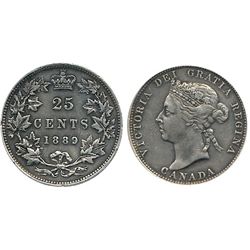
As I mentioned above the 1889 Quarter is the lowest mintage Victorian Quarter (66,340 pieces were struck).
It’s tough to find examples in mid-grades and I’ve only ever seen one mint state example (MS-63).
In low grades the coin can fetch a couple hundred bucks, but prices quickly rise to the $1,000s if you’re lucky enough to find a nice mid-grade example.
Mint state examples will cost significantly more, running into the tens of thousands of dollars.
1893 Quarter Queen Victoria
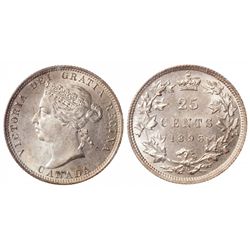
Another low mintage Victorian Quarter is the 1893 with a mintage of about 100,000.
Low grade examples sell for about a few hundred dollars, while high end mint state examples fetch a few thousand.
Given the number of mid and high grade examples I’ve seen, I’d say that 1893s survived in larger numbers than the 1875H or 1889.
1906 Small Crown Edward VII Quarter
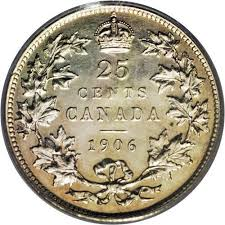
This is perhaps the rarest of rare Canadian Quarters. It’s believed that about 100 coins were made before the mint realized that it used the wrong reverse die.
It’s tough to tell the difference between the Small Crown and Large Crown varieties. In fact, the existence of the Small Crown variety was only discovered in the 1980s.
The difference has to do with the crown at the top of the coin on the reverse side. The design changed in 1906, but a small number were struck using an old die that was used from 1902-1905.
Very few of these coins exist today, and many of them are in extremely low grades of Fair and Good. Low end examples sell for around $1,000, while the highest graded has sold for over $50k at auction.
1915 George V Quarter
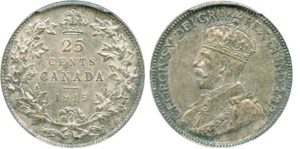
The 1915 George V Canadian quarter is the scarcest date of the entire George V collection. Charlton lists the mintage at just over 242,000 pieces and very few have survived to this day.
Most of the surviving examples are of very poor quality and grade in the “good to very good” range and sell for around $50-$100.
High end examples appear from time to time at auctions with mint-state 63 examples ranging from $5,000-$8,000.
The occasional MS-64 is the highest graded and auction prices range from $10,000 to $14,000.
Of course, those are the two pricing extremes. For a coin investor, I think the key is to pick up a nice mid-grade circulated example.
There seem to be very few of the coins around, but they do show up at auctions from time to time. A VF-20 example can fetch $250, while VF-30’s and EF-40s can sell for $500 and $900 respectively.
1921 George V Quarter
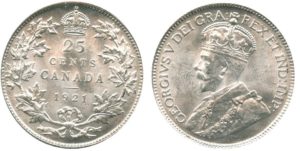
All 1921 silver coins are highly sought after by coin collectors and while it’s not as rare as the famous 1921 50 cents and 1921 5 cents, the 1921 quarter is still a tough date to find.
Low end coins sell for under $50 while the much more scarcer mint state examples can fetch thousands o,r in some cases, tens of thousands.
Again, I think the key for the average coin collector is to find really nice mid-grade examples (EF-AU grades).
These seem to be the most “investable” because they sell from about $350-$900 which is in most collectors’ affordability range.
1936 dot George V Quarter
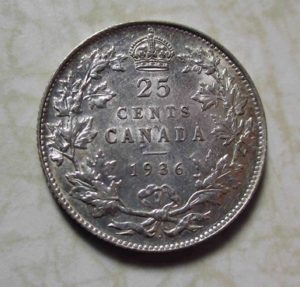
Of all the 1936 “dot” coins it is the quarter that is the most common. The dot coins were made in the midst of Edward VIII’s abdication.
The dot coins were made as an emergency measure to buy time before the mint received new dies with King George VI effigy. The dot simply indicates that it was made in 1937.
Low end examples can be purchased for about $100 while higher end mint-state examples can sell for as high as $5,000 at auctions.
The coins historical significance and scarcity make it a must have coin for any serious quarter collection.
1947 dot George VI Quarter
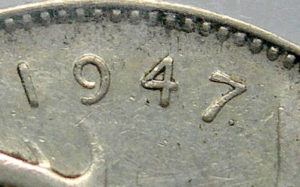
Another famous must have “dot” coin. In 1948, India gained its independence and new dies were created that removed the inscription “Emperor of India” from the obverse side of the coin.
As a way to meet demand for Quarters, the mint produced 1947 Quarters with a small Maple Leaf next to the date to signify that they were struck in 1948.
Those Maple Leaf dies would deteriorate overtime to the point that they would simply produce a small “dot” next to the date.
Low end examples can be picked up for under $100 while the higher end mint state examples sell for about $1,500-$3,500.
1951 Low Relief George VI Quarter
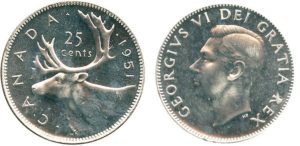
The Royal Canadian Mint produced two different varieties of 1951 quarters. The first is a “high” relief variety which is by far the most common.
Over 8 million 1951 quarters were minted, but examples of the rare and highly sought after “low” relief variety number somewhere in the low thousands if not under 1,000 pieces total.
Most 1951 LRs were found in proof-like sets, but some made their way into circulation.
The easiest way to tell the difference between the two is that on the obverse of the high relief variety, the letter “A” in “DEI GRATIA” points toward a rim denticle; while for the low relief variety, the “A” points in between rim denticles.
I know, not much of a difference but significant enough to make low relief varieties worth several hundreds, if not thousands of dollars.
So get out your magnifying glasses and check those quarters!
1967 Bobcat Nickel Pattern Quarter
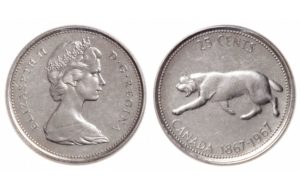
Most people instantly recognize the iconic “Bobcat” coin that was produced in 1967. The RCM minted about 50 million of these beautiful silver quarters.
The silver variety is actually quite common and not a rare coin by any measure. However, a small number (believed to be about 5-10) of pattern 1967 quarters were struck in nickel.
These coins are quite rare and typically fetch $3,000-$5,000 at auction.
1973 Large Bust Mountie Quarter
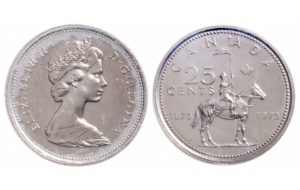
With less than 10,000 pieces believed to have been made, the 1973 Large Bust quarter is one of the more popular rare Canadian coins.
In 1973, to commemorate the 100th birthday of the Royal Canadian Mounted Police, the mint produced hundreds of millions of quarters that depicted a Mountie on horseback.
A small number were made using the obverse of the 1972 Quarter.
Circulated examples can be purchased for around $150, while mint state examples can be found for around $300-$500.
1983 Caribou Quarter
Hey remember the 80s? Me neither! It was also an unremarkable decade for Canadian Quarters too. What can I say there are no rare Canadian quarters for the 1980s.
The 1983 date was the lowest mintage for the decade at a little over 19 million pieces. These examples in certified mint state can sell for $20-$30.
1992 Provincial Quarters with Rotated Die Error
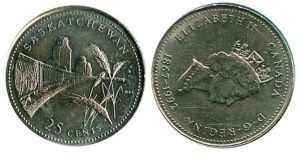
The RCM celebrated Canada’s 125th birthday in 1992 by releasing a special commemorative provincial quarter each month. In general, these coins are not rare at all and many were saved and put away as keepsakes.
That said, some provincial quarters had a type of minting error called a “rotated die.” All that means is that if you look at the obverse side (the Queen’s effigy), and turn the coin around, the portrait on the reverse will be rotated by 90 degrees or 180 degrees.
For years, the coin community has known about the 2 most common provincial coins where this error occurred (the New Brunswick and North West Territories).
I have recently learned of a 3rd and extremely rare example of this error appearing on a Saskatchewan coin. This places the Saskatchewan coin among other rare Canadian quarters.
The other coins sell for about $125-$300, while it remains to be seen how much the lone Saskatchewan error coin will sell for.
2000 P Caribou Quarter
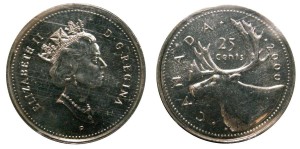
Around the turn of the millennium, the Royal Canadian Mint began experimenting with nickel-plating around a steel inner core. The coins were struck with a small “P” on the obverse side.
A very small number of 2000 “P” Quarters were released into public circulation. If you find one of these in your change, this ultra-rare 2000 P quarter is worth as much as $10k.
2000 Millennium Map Mule and 2007 Wheelchair Curling Mule
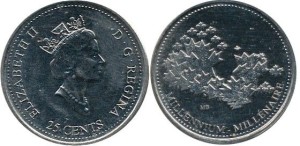
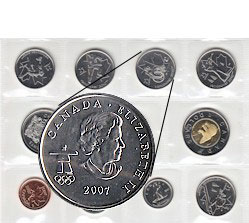
Neither of these coins were ever found in circulation, but they were found in a small number proof-like sets. Both of these coins were error coins that resulted from mismatched dies.
The quality control group at the RCM found and destroyed the majority of the error coins. Therefore, both coins are believed to be extremely rare Canadian quarters with fewer than 100 or so examples in existence.
If you’re lucky enough to find either one of these, you can expect to pay around $500 or more for it.
2010 Commemorative Special Edition Proof Quarter 1935-2010
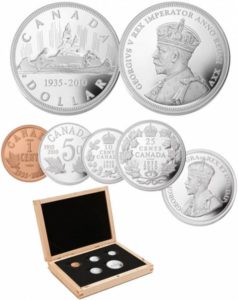
Sadly, there are no rare circulation strike quarters for this decade. Maybe some will appear in 2017 when the RCM issues its new commemorative quarter as it has done for similar occasions in the past.
But for now my pick for this decade is a special proof commemorative quarter that was part of a limited number of 5,000 sets.
They were special limited edition proof sets that commemorated the circulation coinage of 1935. These coins bear the date 1935-2010.
It’s tough to find any single denomination because it would require breaking up the sets to sell the coins individually. These coins sell for about $50 if you’re lucky enough to find one.
My Complete Canadian Quarter Collection!
Do You Have Any Rare Coins? What Are They Worth?
For more information about Rare Canadian coins and what they’re worth check out these titles from Amazon:
James A. Haxby’s A Guide Book of Canadian Coins
For Canadian Coin Values and Prices See Charlton Coin Guide.
Protect and Preserve Your Coins
It’s no secret that the most valuable coins are ones that are well preserved. I highly recommend using the individualized 2×2 coin holder. I’ve used them for years for my own coins and they can be kept in a special coin album.
Thanks for reading my post on Rare Canadian Quarters. If you’ve enjoyed this piece check out my coin articles:
Nice to see a fellow coin collector in the investment community. I completed a Canadian type set back in 2011 and yes quarters made up the largest % of the collection 🙂
I agree you could have list all of the pre 1900 Victoria coins but appreciate you took examples under each monarch. Only coin I would have added would be the 1904 Edward VII. My favorite design is the RMCP quarter and was one of the most used photos from my coin site.
Thanks for the comment and great to hear from you. I think it’s awesome that you completed the type set. I’m still working on a complete date set for my quarters. I agree that the 1904 quarter is definitely a tough coin but got squeezed out of this list for the 1906 small crown.
I got a qtr canada qtr that i havnt seen on here with a fish n some other things on back
Have a nickle canadian looks like the queens eyes have a piece of metal covering her eyes .o & my old cat 25 cent looks nickle how can I tell .
1906 Small Crown Quarter Reverse dies were used from the previous yr of 1905 after being refinished
and used again in 1906. It is unlikely that a die was in service for more than two yrs., as refinishing reduces the die’s life . From the Rarity of this Variety it is very possible that only one Reverse die was carried forward from 1905 to 1906.
1905 mintage 820,465 Obverse 9 Reverse 11 Strikes/Pair of dies 82,046 # good coins struck 800,000
1906 mintage 245,850 Obverse 13 Reverse 17 Large Crown. Strikes/Pair of dies 83,057 # of good coins struck 237,843 Defects 8,007 and were destroyed. Therefor 245,850 Div. by 14 = 17,561 Rounded to the nearest integer represents the average number of coins struck per pair of dies. Between P.C.G.S. and I.C.C.S. there are approximately 103 coins graded as Small Crown in all grades so that represents .0433% of 237,843 Coins.
High Grade SALES
P.C.G.S. MS62 Sold $28,336.05 Cdn. Jan.13,2003.
P.C.G.S. AU55 Sold $14,168.02 Cdn. Jan.13,2003.
P.C.G.S. AU55 Sold $23,521.00 Cdn. Sept. 14, 2006.
P.C.G.S. AU55 Sold by T.C.N.C. about Feb.14,2012 Ask Price was $54,999.00
The Heritage image you have shown is a P.C.G.S. AU55 ( and the nicest of all I have seen ) is for sale and an offer was declined with a counter of $194,114.00 on Sept. 16,2016.
The opportunity to acquire a Rarity is more often Rarer than the collectible itself. Price is secondary , quality comes first.
Like they say buy the coin and not the holder as this coin is nicer than the P.C.G.S. MS62 with a Grey Patina and the most beautiful toning I have ever seen on a coin. This is rarer than the 1921 50 cent that sells in the $ 300,000 to $400,000. range with about 400 known!
TREVOR.
Thanks for the comment Trevor, I knew the 1906 Small Crown was a rare coin but had no idea just how rare the high grade examples are. I like the comparison to the 1921 50 cent, that suggests that a high end 1906 small crown quarter has tons of potential to appreciate in value.
Up Date : The High Grade examples for the 1906 Small Crown Quarter are as follows:
Of the 103 Coins graded by P.C.G.S. and I.C.C.S. there are only Six (6) Coins in High Grade.
P.C.G.S. AU45 (1) AU55 (1 ) AU58 (1) MS62 (1)
I.C.C.S. AU50 (1) AU55 (1)
Note: One Correction to Mention 1921 50 Cent less than 75 Graded Examples , not 400 as mentioned above.
1921 05 Cent less than 400 Graded Examples.
1951 Low Relief Quarter George VI History : Before 1953 the best coins were selected and put in cases called uncirculated sets from R.C.M. ( Master or Deputy Master ) from the ordinary run. The finish on the coins offered, acquired the name Proof-Like from the late Mr, Jim Charlton. The mint did not even acknowledge the early P.L. Sets, yet they are discernable by collectors as having Mirrored Fields. Wikipedia notes that the 1951 Low Relief was predominantly only made available in proof like sets and having a mintage of approximately 500 Mirror Finish sets.
ICCS 2012 Population Report by Brian Cornwell 1951 Low Relief M.S. 17 COINS, 1951 High Relief M.S. 507 COINS 1951 Unattributed M.S. 190 COINS That’s a total o f 714 Coins out of 8,290,719 Minted .
The 1951 Low Relief Business Strikes are Very Rare in Mint State and are on Registry Set Collectors Radar!!
Sales: George Manz Auction Sept. 19,2009 Lot # 74 ICCS M.S. 62 Sold for $1155.00 B/P included
Torex Auction Canadian Numismatic Company Feb.27, 2010 I.C.C.S. M.S. 63 Sold for $1115.00 .
E-Bay Auction Oct.18,2011 ICCS M.S. 62 Sold for $1,378.64
Charlton Catalogue 2016 70th Edition EF40 $350.00 AU50 $500.00 AU55 $ 1000.00 MS60 $1500.00 MS63 $2500.00
Hi, I have recently found a 2006 quarter that is missing the caribou, I have searched everywhere and have ground no information on this and was wondering if you might know something about this error?
Thanks
I haven’t heard of this post a picture of it…maybe a visitor may have some info.
I have a ‘p’ quarter (under the queen) . caribou side has no date however at the bottom of the queens bust its got 1952 2002. Is the missing caribou date due to this 2002 near the bust signifying the date struck?
Hi, yes it is.
I found a 2006 quarter with a teardrop right on the moose. The teardrop clearly has an outline and the inside is a beautiful blue. I have never seen this and can’t find any reference to it online. Is this rare and a mistake? How much would something like this be worth?
Never heard of it. Probably someone altered it.
Thank you for your reply. I showed some colleagues and they thought that it was genuine as well but the colour scraped off once it was forced hard. I thought I had a gem but became a dud.
Hi, first if all I really like your articles.
I was wondering how could you tell the diffrence between 1967 Bobcat nickel quarter and 1967 Bobcat silver/nickel quarter.
Generally speaking, the silver bobcat quarter will tarnish, while the nickel won’t. If you have any other silver coins look at one of them next to a nickel coin, the difference is easy to see.
I have a 1967 bobcat quarter that just does not look silver in amongst silver quarters but does not quite look nickel in nickel coins,is there a real trustworthy place in Alberta to go to.i tried posting a photo but no luck
You can try taking it to Calgary coins. I’m not sure about what their reputation is. Any one out there deal with Calgary coins?
I have 1942 1945 1946 and 1952 quarters and it looks diff material they used that time compare these days.. any value for these quarters?
Fy
Those coins are 80% silver so they are worth their weight in silver at a minimum. If they are mint condition, worth over $100 on the low end. Circulated anywhere from $5 and up.
I got a caribou quarter how would I know if it’s nickel or silver
Sorry bobcat quarter
Silver quarters tarnish or “tone” with age, nickel doesn’t.
I have a 1952 Canadian quarter that has queen Elizabeth on the back. Any idea of what that may be worth?
1953 is the QE II Quarter. in Mint condition you’re looking at about $100
I have 6 of these coins that’s shown!! My son collects everything